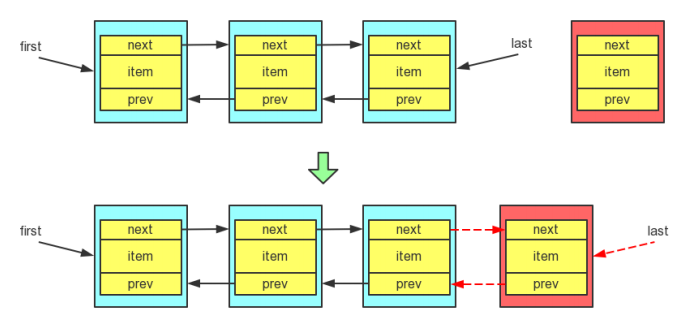Java LinkedList的实现原理图文详解
一、概述
先来看看源码中的这一段注释,我们先尝试从中提取一些信息:
Doubly-linked list implementation of the List and Deque interfaces. Implements all optional list operations, and permits all elements (including null).All of the operations perform as could be expected for a doubly-linked list. Operations that index into the list will traverse the list from the beginning or the end, whichever is closer to the specified index.Note that this implementation is not synchronized. If multiple threads access a linked list concurrently, and at least one of the threads modifies the list structurally, it must be synchronized externally. (A structural modification is any operation that adds or deletes one or more elements; merely setting the value of an element is not a structural modification.) This is typically accomplished by synchronizing on some object that naturally encapsulates the list.
从这段注释中,我们可以得知 LinkedList 是通过一个双向链表来实现的,它允许插入所有元素,包括 null,同时,它是线程不同步的。如果对双向链表这个数据结构很熟悉的话,学习LinkedList 就没什么难度了。下面是双向链表的结构:

双向链表每个结点除了数据域之外,还有一个前指针和后指针,分别指向前驱结点和后继结点(如果有前驱/后继的话)。另外,双向链表还有一个 first 指针,指向头节点,和 last 指针,指向尾节点。
二、属性
接下来看一下 LinkedList 中的属性:
//链表的节点个数 transient int size = 0; //指向头节点的指针 transient Node<E> first; //指向尾节点的指针 transient Node<E> last;
LinkedList 的属性非常少,就只有这些。通过这三个属性,其实我们大概也可以猜测出它是怎么实现的了。
三、方法
1、结点结构
Node 是在 LinkedList 里定义的一个静态内部类,它表示链表每个节点的结构,包括一个数据域 item,一个后置指针 next,一个前置指针 prev。
private static class Node<E> {
E item;
Node<E> next;
Node<E> prev;
Node(Node<E> prev, E element, Node<E> next) {
this.item = element;
this.next = next;
this.prev = prev;
}
}
2、添加元素
对于链表这种数据结构来说,添加元素的操作无非就是在表头/表尾插入元素,又或者在指定位置插入元素。因为 LinkedList 有头指针和尾指针,所以在表头或表尾进行插入元素只需要 O(1) 的时间,而在指定位置插入元素则需要先遍历一下链表,所以复杂度为 O(n)。
在表头添加元素的过程如下:

当向表头插入一个节点时,很显然当前节点的前驱一定为 null,而后继结点是 first 指针指向的节点,当然还要修改 first 指针指向新的头节点。除此之外,原来的头节点变成了第二个节点,所以还要修改原来头节点的前驱指针,使它指向表头节点,源码的实现如下:
private void linkFirst(E e) {
final Node<E> f = first;
//当前节点的前驱指向 null,后继指针原来的头节点
final Node<E> newNode = new Node<>(null, e, f);
//头指针指向新的头节点
first = newNode;
//如果原来有头节点,则更新原来节点的前驱指针,否则更新尾指针
if (f == null)
last = newNode;
else
f.prev = newNode;
size++;
modCount++;
}
在表尾添加元素跟在表头添加元素大同小异,如图所示

当向表尾插入一个节点时,很显然当前节点的后继一定为 null,而前驱结点是 last指针指向的节点,然后还要修改 last 指针指向新的尾节点。此外,还要修改原来尾节点的后继指针,使它指向新的尾节点,源码的实现如下:
void linkLast(E e) {
final Node<E> l = last;
//当前节点的前驱指向尾节点,后继指向 null
final Node<E> newNode = new Node<>(l, e, null);
//尾指针指向新的尾节点
last = newNode;
//如果原来有尾节点,则更新原来节点的后继指针,否则更新头指针
if (l == null)
first = newNode;
else
l.next = newNode;
size++;
modCount++;
}
最后,在指定节点之前插入,如图所示

当向指定节点之前插入一个节点时,当前节点的后继为指定节点,而前驱结点为指定节点的前驱节点。此外,还要修改前驱节点的后继为当前节点,以及后继节点的前驱为当前节点,源码的实现如下:
void linkBefore(E e, Node<E> succ) {
// assert succ != null;
//指定节点的前驱
final Node<E> pred = succ.prev;
//当前节点的前驱为指点节点的前驱,后继为指定的节点
final Node<E> newNode = new Node<>(pred, e, succ);
//更新指定节点的前驱为当前节点
succ.prev = newNode;
//更新前驱节点的后继
if (pred == null)
first = newNode;
else
pred.next = newNode;
size++;
modCount++;
}
总结
以上就是这篇文章的全部内容了,希望本文的内容对大家的学习或者工作具有一定的参考学习价值,谢谢大家对脚本之家的支持。如果你想了解更多相关内容请查看下面相关链接
您可能感兴趣的文章:
- Java集合之ArrayList和LinkedList的实现原理以及Iterator详解
- Java LinkedList的实现原理详解
- Java集合之ArrayList和LinkedList的实现原理以及Iterator详解
- Java LinkedList的实现原理
- Java中LinkedList实现原理
- Java集合7:LinkedList的实现原理
- Java 学习系列:LinkedList 的实现原理
- Java LinkedList 实现原理
- 【Java】LinkedList 底层原理,自己实现LinkedList
- Java集合,LinkedList底层实现和原理
- Java LinkedHashMap的实现原理详解
- 深入Java集合学习系列:LinkedList的实现原理
- Java LinkedList 实现原理及数据接口
- java集合LinkedList的底层实现源码详解
- Java数据结构 LinkedList实现及详解
- java LinkedList实现原理概述
- Java集合:LinkedList的实现原理
- 对ArrayList和LinkedList底层实现原理详解
- Java的数据结构相关的类实现原理,比如LinkedList,ArrayList,HashMap,TreeMap
- 深入Java集合学习系列:LinkedList的实现原理
